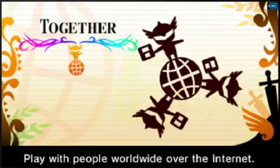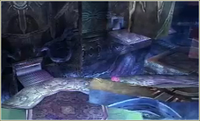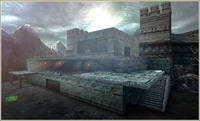Together Mode

The Multiplayer Mode in Kid Icarus: Uprising is a brand new feature to the series that allows six players to battle each other in what appears to be a combat training program. The entire mode plays in the same way as the ground missions of the game, with the on-rails flight mechanics never being used during any part of a match. It was first introduced at E3 2011 and allows 3 on 3 battles using the same weapons that are featured in the single player campaign. Multiplayer also features both normal Pit and Dark Pit, as well as the Fighters with which you will primarily use in battle. A minimum of two players are required to play this mode; any unoccupied spaces will be filled in by a CPU.
Game Modes
There are two modes in Together mode:
Light vs. Dark

The rules of this mode are both unique and simple. All six players are divided into two teams: Light Team and Dark Team. Each team consists of three Fighters with separate health bars and each armed with a weapon of choice as well as their own Powers. In addition to the individual health bars, each team also has a life gauge that is depleted each time a team member is eliminated. The main goal of the game is to keep defeating the opposing team's Fighters until their life gauge is depleted. Once that occurs, the enemy team's last defeated member will spawn as either Pit or Dark Pit, depending on the team's color. At this point, the life gauge for that team will be used as the angel's health bar, and once again must be depleted for the other team to win. However, angels are much stronger in battle and have more health than the typical Fighter, making teamwork very necessary to beat the enemy. If a player other than the angel is defeated, the angel's health bar is depleted as a life gauge, however Health Recovery, can restore the gauge as a life meter.
Free-for-All

This mode has no teams and no angels, instead having different colored Fighters battle each other until the time limit is over. Who ever receives to highest overall score wins. Like team matches, players will be able to equip their weapon of choice as well as a number of Powers for use throughout the match. Some of the battlefields in Free-for-All are also considerably smaller than those of Light vs. Dark. This mode can be played with less than six people, although computerized characters will fill in the rest of the slots.
Rules
Weapons and Items
At the beginning of each match, all of the players will be able to choose amongst the weapons they have collected during the single player campaign. In addition, some well known items can also be found such as Food to replenish health. Finally, Powers can be used to heal oneself or execute powerful attacks against opponents. Exclusive weapons found only in Together mode are also included. Examples are Medusa Heads, Capture Circles and Chomp Traps.
Daybreak
For the main article, please see Daybreak.
The most notable weapon which is unique to this mode is Daybreak. It consists of three parts to be found, Daybreak A, B and C. Once combined, it unleashes a mighty blast that, if positioned correctly, will knock out foes without a doubt. It is a device exclusively created for Together mode; a device which can easily tip the battle in your favour when in peril.
Weapon Value
The value of one's weapon affects both game modes of multiplayer. In Light vs. Dark, the higher the value of the weapon, the greater the amount of a team's life gauge will drop. So in this instance, using powerful weapons in the battlefield isn't always necessarily the best strategy. In Free-for-All, the player that defeats a foe with a high weapon value will receive more points.
Stamina
As in Solo Mode, each Fighter will also have a limited amount of stamina during battle. If a player runs for too long or uses too much energy (causing sweat to drop from them) to climb up a hill or round a path, they will begin to slow down and stumble while flashing red. Until a player completely stops to catch their breath for a few seconds, they will remain extremely vulnerable to attack.
Rewards
After a battle has finished, players will be given a sum of hearts depending on how well they did. They may be even rewarded with Weapons, Powers and even Idols. The chances for better rewards increase if the player fights with more people and by fighting friends registered on their friend list. Individuals that do very little during a match will not be rewarded anything, regardless if their team won or not.
Stages
The Multiplayer Mode will feature a number of stages for players to battle in. Most of them will likely be based on locations featured in the story mode. So far, multiple different stages have been confirmed:
| For the main article, see Windy Wasteland. This basic example of a battle stage is normally the first to be encountered by Fighters. It has a grassy themed appearance coupled with some temple ruins. |
File:Arena grassland.png | |
| For the main article, see Lava Basin. The second stage normally encountered by Fighters, Lava Basin is set around the vent of a volcano. The terrain mainly included molten rock and chain-linked bridges. |

| |
| For the main article, see Starlight Observatory. The third stage in Together Mode. This battleground is always fought at nighttime, adding to the mysterious effect of glass structures found within. |

| |
| For the main article, see Ancient Fortress. The fourth stage in Together Mode. The fragmented castle provides both perfect aerial sniping and secret hiding spots for those in peril of death. |

| |
| For the main article, see Twilight Stratosphere. The fifth stage in Together Mode. This battleground features the Thunder Cloud Temple music. Set high up in the sky, it is very fragmented. |
??? | |
| A desert-based arena located around a tiled building. It has a large, open balcony in addition to its smaller indoor areas. Main fights occur within the huge room in the center of the stage. Escaping and entering this location is quite simple thanks to an orange Jump Pad and a huge open rooftop above the area. For sneaky attackers, the two main respawning areas are within the building near the parallel staircases or outside of battlegrounds in the outskirts of the desert. This stage is relatively bare, containing no strategic hide-outs or hidden passages. | ??? | |
| For the main article, see Rail Temple. The seventh stage of Together Mode. As its name implies, Grind Rails are used here, the only battleground to do so. |
File:Arena ruins.png | |
|
Cave of Spirits |
This arena has a collection of mysterious crystal walls and pillars inside it, referencing the Spirits it has mentioned in its title. With no real tricks or any hazards, this stage is popular among cautious players wanting more safety than excitement. However, what it lacks in this, it makes up for the multiple pathways and passages, causing Fighters to run in circles before meeting the opponent desired. Angels may feel secure here, especially if they manage to find the cave's few exits thanks to a nifty bridge and a couple of winding paths. The main battle normally occurs in the heart of the arena, among the beautiful crystal structures. | ??? |
|
Forgotten City |
??? | ??? |
|
Spiral Tower |
A medium-sized field with a tall tower in the corner of the stage. The tower has a spiral ramp leading to the top. While perfect for angels seeking peace and snipers looking for a vantage point, getting to the top can be perilous since only a Power can grant one long run to the peak. The field below is rocky and relatively level, but there are some sections with multiple heights. This battleground is always fought at sunset, with a nice soothing orange sky to behold. | ??? |
|
Large Arena |
A flat, wide open, circular stage divided into four sections. No obstacles on this stage makes for a consistent fight with nowhere to hide. This is essentially a giant version of the Small Arena. | ??? |
|
Small Arena |
A flat, wide open, circular stage lacking obstacles. Very similar to the Large Arena but much smaller. | ??? |
Connectivity

The game is confirmed to support local and online multiplayer, allowing six people nearby or across the globe to battle each other in both random and friend matches. Uprising uses the Nintendo Network instead of Nintendo Wi-Fi Connection, the first official game to do so.